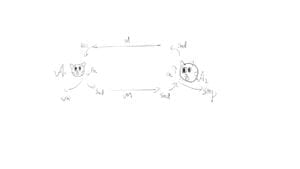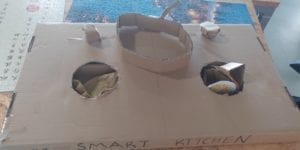Definition
An interaction system involves (at least) 2 agents A, each contains 3 functions: .
Rec is the receiving function that receives the information send by another agent.
Prc is the processing function that process the information. It decides what new information it the agent would generate from the information received. It also judge whether to end the interaction process.
Snd is the sending function that send the new information to another agent.
The system also contains an action loop: the two parties keeps running the three function until one’s Prc function decides to stop.
A simple illustration is shown as below:

This definition is inspired by the readings as well as the research. It is also improved by the discussion with my group during making our project.
Both the reading of interaction and the reading of physical computing cover an important idea, that there is a action – process – reaction process between two clients for an interactive system. In the reading the Art of Interactive Design (Crawford) and Physical Computing – Introduction (O’Sullivan and Igoe) the author analyzed several cases that are not interactive devices: such as the folding tree branch example, the branch is not reacting. But for me the more important is that after the tree behaves, the process is over, and human don’t need to react based on tree’s reaction. It is a one way “interaction”. Another example is that, when we turn on a light, we act on the button and the circuit processes, then the light turns on. It somehow fit the action – process – reaction model but for me it is weird to call it an interaction.
From https://www.creativeapplications.net/ we find two projects.
I actually had a basic idea of the definition before I searched the project, then I wanted to try and see whether the definition successfully describe the reality while browsing the projects on the websites. The first one, the Algorithmic Drive exemplified the interaction process. Human sent out controls by using the panel, the machine receives and display different images on driving, then a human see the images and resend new command to create artwork or have fun. The loop continues until a human decides to stop playing. This project shows the whole process accurately, proving the definition supports the reality of interactive devices.
For the second one, Artificial Arcadia, it is also a interactive device, and it seems also fits less to my definition. But the tricky thing is here: The device receives the information of a human and react. But the human does not need to care about the information sent by the device, one moves wherever he wants and it has little to do with the falling of the device. So the loop that is shown in the definition ends here. When a human move to a new place in the device, it actually starts a new loop but not continues the old one.
This idea and the definition helps in our own project. At first another group member proposed an idea of making a magic wand that can achieve many functions. Despite other arguments from others such as “it is not applicable even 100 years later” and “it is just a copy of harry potter”, I argued that it is not an interaction at all. A human just send a command to the wand and it executes, it does not fit the definition (it does not even finish one loop). Then we found we all agreed that interaction involves two parties with the three function. However some thought my definition on the loop part is too strict (as I thought the loop should be executed many times). Finally we decided to use a lower bound: after a human sends information as long as a human receives the information of the device and act upon it then call it a stop (that is, one complete cycle shown in the graph), it could be count as an interaction. Finally we decided to make a sensor system paired with a smart kitchen that will prepare meals according to your mood and health. In the last moment of our project presentation scene 3, the boyfriend (acted by me), felt less worried and tricked his girlfriend that he had prepared the anniversary after the machine offered help. It finished the cycle of interaction (loop once). In the QA session we explained that the machine could observe and learn from the user’s habits for better service, it is a long term interaction with loop for many times. Clearly, this device also involves the three functions on both agents.

A photo of our prototyping.
During the QA session the professor proposed an interesting idea that our focus is more on the sensor system, while the smart kitchen itself is a great device. It is indeed. The two devices are a pair. And for me I think the sensors are still a crucial part as it add more interesting interactions to the system. Our information sent out is not in the form of language anymore, but chemicals, health signals etc. and the device can make decision “by itself”. The smart kitchen need more focus in the presentation, while without the sensors the whole project would become like “I tell the kitchen to make a pizza and it makes a pizza”.
What I want to say is that, I believe in this project it does not matter so much what magical function we imagined in the project, whether a magic kitchen or a mirror or a time machine. After all we cannot make them. What matters is how we involve the idea of interaction in it. The theory of interaction has already been proposed, but even 100 year later we can still use this theory and the idea of interaction to transform some mundane functions into something interesting and novel. That, together with how we are going to do it, is what we all need to learn in the project and the class.